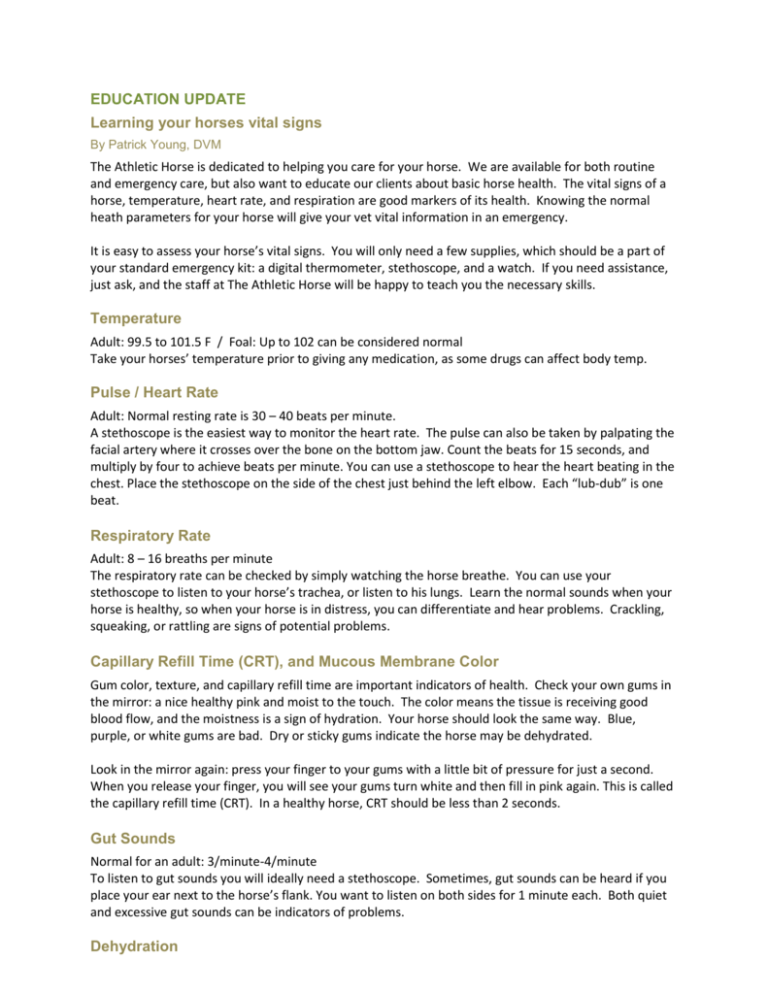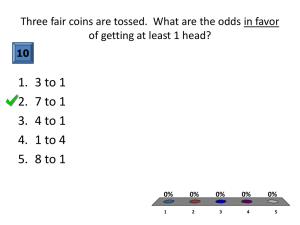Learning Your Horses Vital Signs
advertisement

EDUCATION UPDATE Learning your horses vital signs By Patrick Young, DVM The Athletic Horse is dedicated to helping you care for your horse. We are available for both routine and emergency care, but also want to educate our clients about basic horse health. The vital signs of a horse, temperature, heart rate, and respiration are good markers of its health. Knowing the normal heath parameters for your horse will give your vet vital information in an emergency. It is easy to assess your horse’s vital signs. You will only need a few supplies, which should be a part of your standard emergency kit: a digital thermometer, stethoscope, and a watch. If you need assistance, just ask, and the staff at The Athletic Horse will be happy to teach you the necessary skills. Temperature Adult: 99.5 to 101.5 F / Foal: Up to 102 can be considered normal Take your horses’ temperature prior to giving any medication, as some drugs can affect body temp. Pulse / Heart Rate Adult: Normal resting rate is 30 – 40 beats per minute. A stethoscope is the easiest way to monitor the heart rate. The pulse can also be taken by palpating the facial artery where it crosses over the bone on the bottom jaw. Count the beats for 15 seconds, and multiply by four to achieve beats per minute. You can use a stethoscope to hear the heart beating in the chest. Place the stethoscope on the side of the chest just behind the left elbow. Each “lub-dub” is one beat. Respiratory Rate Adult: 8 – 16 breaths per minute The respiratory rate can be checked by simply watching the horse breathe. You can use your stethoscope to listen to your horse’s trachea, or listen to his lungs. Learn the normal sounds when your horse is healthy, so when your horse is in distress, you can differentiate and hear problems. Crackling, squeaking, or rattling are signs of potential problems. Capillary Refill Time (CRT), and Mucous Membrane Color Gum color, texture, and capillary refill time are important indicators of health. Check your own gums in the mirror: a nice healthy pink and moist to the touch. The color means the tissue is receiving good blood flow, and the moistness is a sign of hydration. Your horse should look the same way. Blue, purple, or white gums are bad. Dry or sticky gums indicate the horse may be dehydrated. Look in the mirror again: press your finger to your gums with a little bit of pressure for just a second. When you release your finger, you will see your gums turn white and then fill in pink again. This is called the capillary refill time (CRT). In a healthy horse, CRT should be less than 2 seconds. Gut Sounds Normal for an adult: 3/minute-4/minute To listen to gut sounds you will ideally need a stethoscope. Sometimes, gut sounds can be heard if you place your ear next to the horse’s flank. You want to listen on both sides for 1 minute each. Both quiet and excessive gut sounds can be indicators of problems. Dehydration Dehydration occurs when there is excessive loss of water in the horse's body. While there are many causes, strenuous exercise, excessive heat, or digestive imbalances are the most common. The loss of water and electrolytes -- minerals like sodium, chloride, and potassium -- is a serious emergency that can lead to organ failure. To check for dehydration, pinch a flap of skin along the horses neck ~ it should snap back quickly. Skin that remains tented is an indication of a serious problem.







